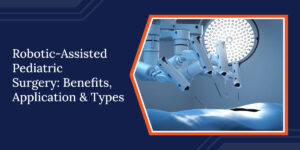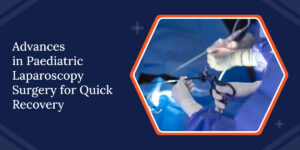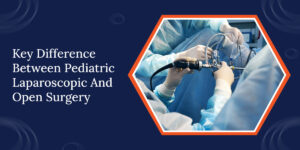
In this blog, we will cover its benefits, applications and types. So, keep reading!
A] Overview of Pediatric Robotic Surgery
Robotic-assisted paediatric surgery is an advanced and minimally invasive procedure for paediatric patients. It is performed through a surgical robot system (also known as the da Vinci system), where a skilled surgeon controls robotic arms with a dedicated console. The robotic system also consists of a high-definition 3D camera that gives the surgeon a magnified, three-dimensional view of the surgical area. It is sought after for its incredible safety procedure and faster recovery compared to traditional surgical options for small children, leading to shorter hospital stays.
Explore Robotic Pediatric Surgery – Learn More Now
B] Advantages of Robotic Surgery in Paediatrics
1. Minimally Invasive Approach
Robotics in paediatric surgical practice allows surgeons to perform minimal surgical incisions in targeted areas. This minimally invasive method significantly reduces trauma to the surrounding tissues. As a result, children experience less post-operative pain, faster healing, shorter hospital stays, and minimal scarring.
2. Enhanced Precision
The robotic system’s articulated instruments enhance dexterity and range of motion, surpassing the human hand’s natural movements. This precision is crucial in delicate paediatric procedures, allowing surgeons to perform complex tasks in confined anatomical spaces with minimal error.
3. Reduced Blood Loss and Pain
Robotic technology allows more controlled movements and accurate dissection, reducing blood loss during surgery. This leads to less post-operative discomfort for the child, quicker recovery, and hospital discharge.
4. Better Visualisation
Robotic systems offer surgeons a magnified, high-definition, three-dimensional view of the surgical field. This improved visualisation helps identify critical structures and enhances the surgeon’s ability to navigate challenging areas confidently.
5. Fewer Post-operative Complications
Combining smaller incisions, improved precision, and superior visualisation contributes to a lower risk of complications. Children typically return to normal activities sooner and with fewer follow-up procedures.
C] Applications of Robotic Paediatric Surgery
Below are some of the key areas where robotic surgery is making a significant impact in paediatric care:
1. Urological Surgeries
One of the most common applications of robotic surgery in paediatrics is correcting congenital urological abnormalities. Procedures such as pyeloplasty for ureteropelvic junction obstruction, ureteral reimplantation, and management of vesicoureteral reflux benefit greatly from robotic assistance. The precision of robotic arms allows for delicate reconstruction in small anatomical spaces, reducing trauma and improving functional outcomes. If you are a parent seeking expert care in this field, you can consult a paediatric urologist in Dubai for advanced and compassionate surgical solutions.
2. Gastrointestinal Surgeries
Robotic systems are also used to treat various gastrointestinal disorders in children. Conditions such as Hirschsprung’s disease, gastroesophageal reflux, and achalasia can be effectively managed with robotic techniques. The enhanced visualisation and fine motor control assist surgeons in performing complex dissections and suturing with high accuracy.
3. Thoracic Surgeries
In paediatric thoracic surgery, robotic assistance is useful in addressing lung malformations, mediastinal masses, and other conditions within the chest cavity. The minimally invasive approach allows for reduced postoperative pain and better preservation of respiratory function, which is crucial in young patients.
4. Oncological Procedures
Robotic surgery offers high precision when excising tumours, making it valuable in paediatric oncology. The improved dexterity and visualisation help surgeons remove tumours while sparing surrounding healthy tissue, which is especially important for growing children.
5. General Paediatric Surgeries
General procedures such as inguinal hernia repairs, appendectomy treatment, and cholecystectomies can be effectively performed with robotic assistance. These surgeries benefit them with smaller incisions, shorter recovery times, and improved aesthetic outcomes.
D] Common Paediatric Robotic Surgeries
1. Robotic-Assisted Pyeloplasty (Kidney Surgery)
Robotic-assisted pyeloplasty (kidney surgery) is the most commonly performed paediatric robot-assisted surgery. The procedure corrects ureteropelvic junction obstruction (UPJ obstruction), an area where the ureter connects to the renal pelvis. Robotic pyeloplasty effectively restores normal urine drainage, improving kidney function while reducing the need for large incisions. As a result, young patients experience shorter hospital stays, less pain, and faster recovery.
2. Robotic Ureteral Reimplantation
Another widely performed procedure is robotic ureteral reimplantation, primarily used to treat vesicoureteral reflux (VUR). VUR is a condition where urine flows backwards from the bladder to the kidneys, increasing the risk of infections and kidney damage. Robotic surgery offers a less invasive solution with enhanced cosmetic results and a quicker return to normal activities compared to traditional open methods.
3. Robotic-Assisted Hernia Repair
Robotic-assisted hernia repair is also commonly performed in paediatric patients. It treats inguinal and diaphragmatic hernias, providing better visualisation and precision. This technique allows for accurate placement and repair with minimal tissue damage.
4. Robotic Fundoplication (Anti-Reflux Surgery)
For children suffering from severe gastroesophageal reflux disease (GERD), robotic fundoplication is an effective anti-reflux surgery. It strengthens the lower oesophageal sphincter, reducing acid reflux and improving the child’s quality of life. The robotic platform provides meticulous reconstruction while reducing post-operative discomfort.
5. Robotic-Assisted Tumour Resection
Lastly, robotic-assisted tumour resection is increasingly used in paediatric oncology, particularly for tumours located in the urinary tract, thoracic cavity, and abdomen. This minimally invasive approach allows surgeons to precisely remove tumours while preserving surrounding healthy tissues, which is critical in growing children.
Explore Robotic Pediatric Surgery – Learn More Now
Conclusion
Robotic-assisted paediatric surgery is a highly effective and minimally invasive surgical procedure using guided robotic arms. The precision, rapid recovery time, and comparative safety of robotic-assisted paediatric surgery make it an increasingly popular surgical option for paediatric conditions.
If you are looking for a highly capable paediatric urologist in Dubai, look no further than Dr Bhusanrao Jadav. He has successfully performed many robotic-assisted paediatric surgeries with an excellent success rate and negligible post-surgical complications. Book your consultation now!

Dr. Bhushanrao Jadhav
Dr. Bhushanrao Jadhav is a highly skilled Pediatric Surgeon and Urologist specialising in minimally invasive and robotic surgeries for children. With advanced training from leading institutions in the UK, India and USA, he brings expertise in treating complex genitourinary conditions and neonatal surgical ailments. Driven by compassion and innovation, Dr. Jadhav has pioneered pediatric robotic surgery programs in Pune, India, ensuring world-class care tailored to children’s unique needs.




















